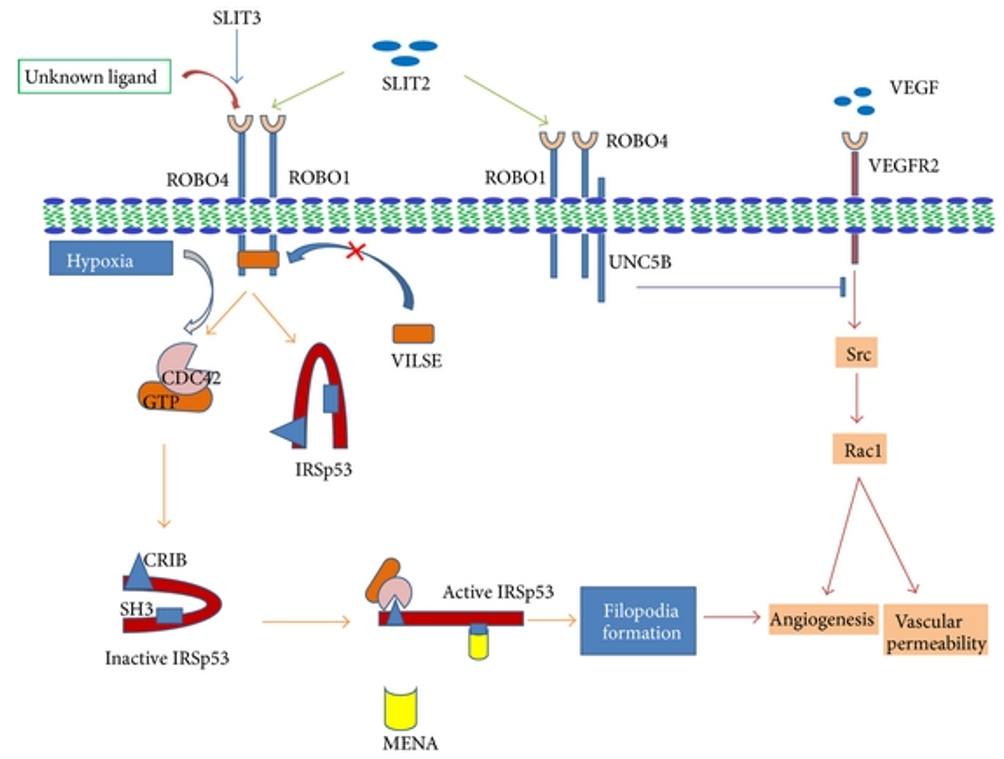
Our promise to you:
Guaranteed product quality, expert customer support.
 24x7 CUSTOMER SERVICE
24x7 CUSTOMER SERVICE
 CONTACT US TO ORDER
CONTACT US TO ORDER
ROBO4 Gene Editing 
ROBO4 was discovered 15 years ago in a bioinformatics search for endothelial-specific transcripts and originally named Magic Roundabout, to denote its homology to Robo receptors and its selective expression on endothelial cells in actively growing tumor vessels. Robo4 encodes a 140 kDa protein that comprises a 60 kDa extracellular domain (ECD) with two fibronectin-repeat regions and two immunoglobulin (Ig)-like domains, a transmembrane domain and an intracellular domain (ICD) devoid of known catalytic sequences. Robo4 is upregulated in endothelium of embryonic blood vessels and in micro-vessels of patients with tumors and vascular injury, but it is also visible in quiescent endothelium. Functionally, Robo4 signaling induces inhibition of endothelial cell migration and is partially mediated by interfering with the Ras-Raf-Mek-Erk pathway. The corresponding ligands of Robo4 are the Slit proteins, which are large secreted proteins encoded by a family of three genes (Slit 1-3). Slit 2 was found to interact with Robo4, regulate endothelial cell migration and participate in tumor angiogenesis.
The Function of Robo4 in Angiogenesis
Robo4 was initially detected in the vasculature at sites of active angiogenesis, including the placenta and various tumors. Many subsequent studies have investigated Robo4 expression in physiological and pathological angiogenesis and revealed that Robo4 is involved in regulating angiogenesis during vascular development in tumors and during ocular neovascularization. ROBO4 inhibits the pathological angiogenesis through counteracting the VEGF signalling either via SLIT2 or through interacting with UNC5B. This inhibition mechanism may depend on SLIT2-ROBO1 and ROBO1-ROBO4 interactions. ROBO4 signalling also promotes pathological angiogenesis either through the SLIT2/ROBO1-ROBO4 axis or through the interaction of ROBO4 with an unknown ligand other than SLIT2. SLIT2 signalling via ROBO1-ROBO4 heterodimerization and srGAP interaction with the cytoplasmic region of ROBO1 may be responsible for proangiogenic attraction guidance signalling in endothelial cells. Since ROBO4 has dual behavior of promoting and inhibiting angiogenesis depending on cell/tissue type, the therapeutic agents with the properties of promoting and inhibiting ROBO4 signalling, respectively, can be used to target tumor angiogenesis according to the cell/tissue type under consideration.
 Figure 1. Schematic diagram of SLIT/ROBO signalling during angiogenesis. (Yadav S S, Narayan G., 2014)
Figure 1. Schematic diagram of SLIT/ROBO signalling during angiogenesis. (Yadav S S, Narayan G., 2014)
Robo4 and Tumors
Robo4 is differentially expressed between the normal and tumor vasculature, suggesting that Robo4 expression may reflect tumor angiogenesis and become a potential target for tumor therapy. The first Robo4 targeting strategy is the injection of high doses of the recombinant Slit2 protein. Slit2 expression was down-regulated in grade III-IV glioma tissues, and the migration, viability and tube formation of ECs were significantly reduced in the Robo4 overexpression group that was pretreated with exogenous Slit2. Therefore, Robo4 inhibits glioma-induced EC proliferation, migration and tube formation through binding to its ligand Slit2. The second Robo4 targeting strategy is to target Arf6 downstream of Robo4 using the small molecule drug SecinH3. Treatment of breast cancer cells with SecinH3, a small molecule that could enhance Robo4 signaling by deactivating Arf6 activating proteins downstream of Robo4, significantly inhibited tumor growth, suppressed lung metastasis, reduced tumor aggressiveness and saved the loss of the ZO-1 protein in ECs without inducing weight loss in mice. Therapies targeting the tumor vasculature include antiangiogenic treatments and treatments that damage established tumor vessels. Tumor endothelial-specific expression of Robo4 in adults suggests that this plasma membrane protein represents an antitumor target for immunotherapy, such as vaccination. Compared with control Fc-immunized mice, Robo4-Fc-vaccinated mice showed retarded lung carcinoma growth, increased vascular leakage and intensified inflammation. The fourth Robo4 targeting therapy combines the high cell-internalizing anti-Robo4 antibody with anticancer drugs and targets the tumor vascular with high specificity and efficiency.
ROBO4 Gene Editing Services
CRISPR/Cas9 PlatformCB at Creative Biogene is dedicated to offering comprehensive CRISPR/Cas9 gene editing services and products for academic research, biotech research and pharmaceutical drug discovery. With deep gene editing knowledge and extensive experience in experimental operation and data processing, we help you effectively control ROBO4 genes knockout/knockin/point mutation in cells or animals via CRISPR/Cas9 technology.
| Service | Details | Alternative cell lines or animal species |
| ROBO4 Gene Editing Cell Line Generation | gRNA design and synthesis Transfect the cell lines you're interested Select the high expression cells and sort monoclonal cell Validate the knockout/knockin/point mutation of ROBO4 by PCR and sequencing Provide cryogenically preserved vials of stable cells and final reports | HEK239T, Hela, HepG2, U87, Ba/F3, CHO, MDA-MB-453, MDA-MB-231NIH3T3, T47D, Neuro2a, MCF7, RKO, K562, RAW264.7, etc. |
| ROBO4 Gene Editing Animal Model Generation | ROBO4 gene conventional knockout animals ROBO4 gene conditional knockout animals ROBO4 point mutation animals ROBO4 knockin animals | Mouse, rat, rabbit, zebrafish, C. elegans, etc. |
Related Products at CRISPR/Cas9 PlatformCB
References
- Zhuang X, et al. Robo4 vaccines induce antibodies that retard tumor growth. Angiogenesis, 2015, 18(1): 83-95.
- Dai C, et al. Regulatory mechanisms of Robo4 and their effects on angiogenesis. Bioscience reports, 2019, 39(7).
- Yadav S S, Narayan G. Role of ROBO4 signalling in developmental and pathological angiogenesis. BioMed research international, 2014, 2014.
- Pircher A, et al. Robo 4-the double-edged sword in prostate cancer: impact on cancer cell aggressiveness and tumor vasculature. International journal of medical sciences, 2019, 16(1): 115.
- Zhang F, et al. The Robo4 cytoplasmic domain is dispensable for vascular permeability and neovascularization. Nature communications, 2016, 7(1): 1-14.